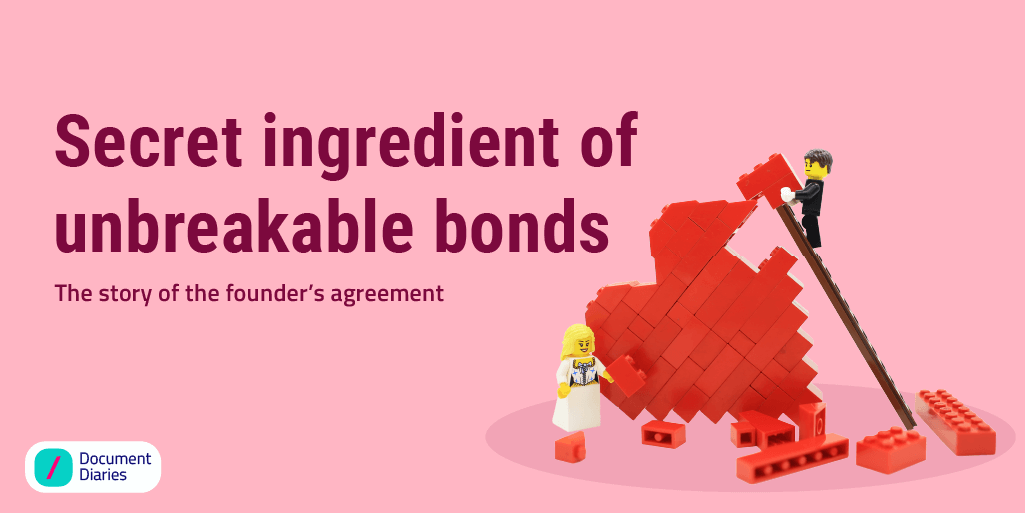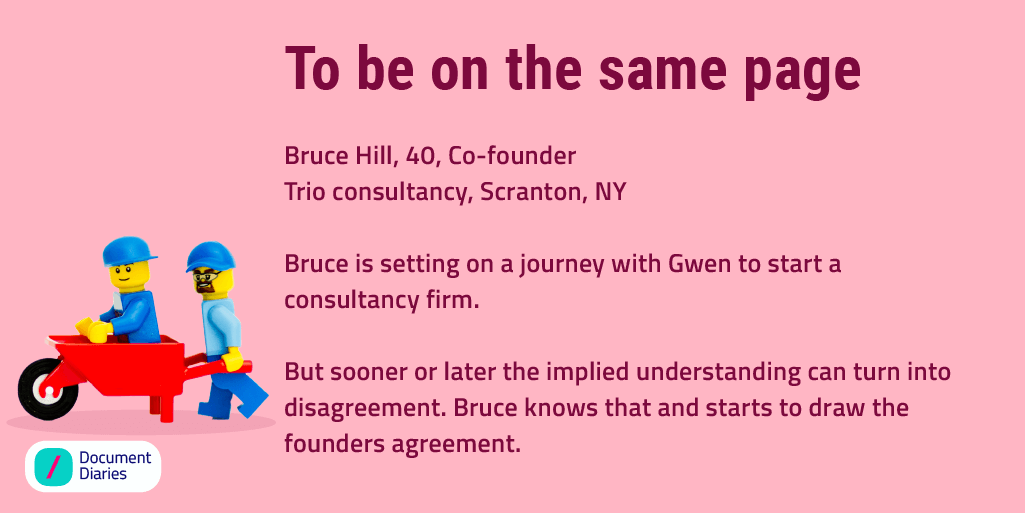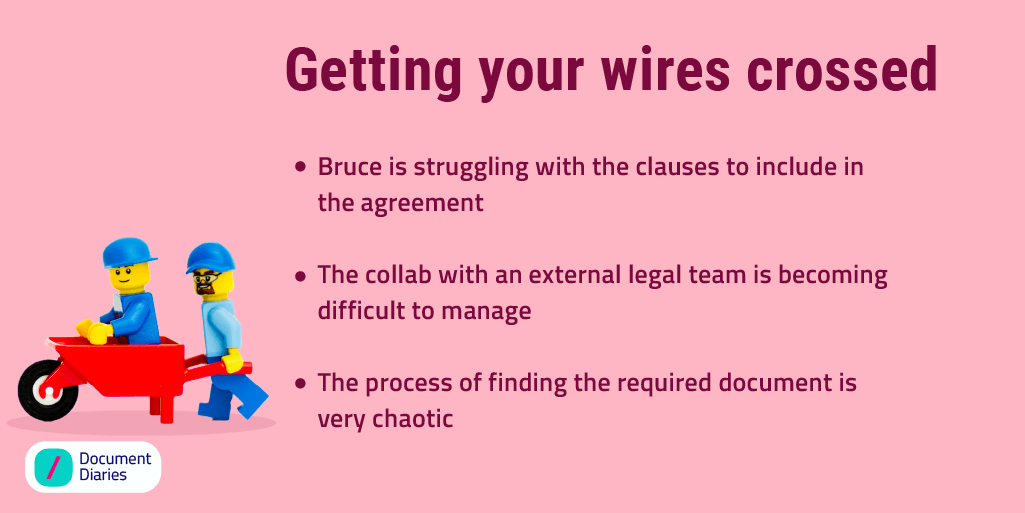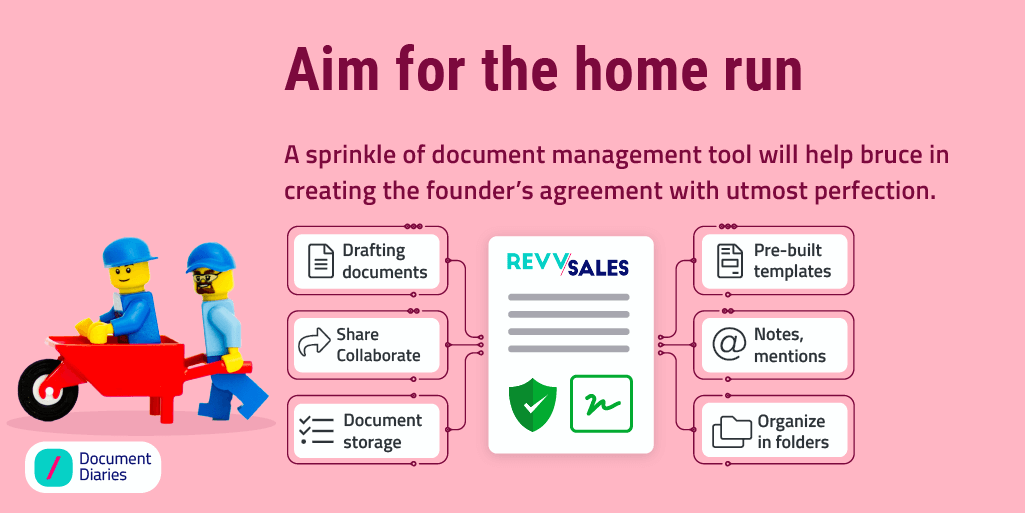There’s no rule that says you must have 2 or more founders to start a venture. Conventional wisdom, however, says that having two or more founders at a startup significantly increases the chance of success. The icing on the cake is when the founders are a diverse bunch, each with their unique strengths to help build the business. But right there also lies a conundrum! When two founders think and operate differently, there will be disagreements. Every business goes through challenges and tough times, and disagreements turn nasty leading to fallouts. This is where a founder’s agreement document comes in. The agreement articulates the responsibilities, ownerships, and initial investment by each founder. Also captured is the process to manage exits as well as conditions that can lead to one, while keeping the company’s interest paramount.
The meet and greet
Bruce Hill, 40, is an entrepreneur. He recently quit his job to start a management consultancy firm, with his co-founder Gwen Wilson. Both Bruce and Gwen have over 15 years of work experience and hold expertise when it comes to improving the efficacy and profitability of an organization.

They both conduct themselves professionally in all work matters. Be it disagreements over a particular hire or discussion over internal process changes, they do what’s best for the firm. But businesses don’t run smoothly over verbal agreements and Bruce understands that very well.
He spoke to Gwen about drafting a founder’s agreement document between them. The agreement will outline each of their responsibilities and ownership and can act as a mediator in situations of disagreements.

Why is it important to create a founder’s agreement?
A founder’s agreement is a legally binding document that consists of several key issues about running a business. It helps settle disputes resulting from differences between the founders. The agreement is designed to protect each member’s interest and avoid future conflicts. It is advised to draft this agreement at the incorporation of the new venture.
Mr. Bruce is all on board to start the drafting process. He has been researching about the founder’s agreement. How to draft a founder’s agreement? What can they include and whose help do they need? What should be included in the agreement and what not? Too much information has left them dazed and confused.
Founder’s agreement – what do we include?
Here are some of the key elements that Mr. Bruce should focus on when drafting the agreement.
Primary responsibilities
Mr. Bruce should ensure that there is clear outlining of their roles and responsibilities. He understands that it is critical to collaborate and create a culture that is open and shared but he or Gwen individually cannot be in charge of everything. The founder’s agreement will help them establish clear lines of primary responsibilities and enable a functional management system for the smooth running of their business.
Ownership structure
The agreement should clearly define the ownership structure of the startup between the founders. This will include the percentage of the initial capital contributions made by each founder and the number of equity shares that each of them holds. It should also specify the plan of action for equity ownership in case of the death or removal of a founder.
Equity ownership and vesting
It is critical that some restrictions are laid on the ownership and transfer of shares by the founders. Here are a few things that Mr. Bruce should focus on
- Specify a vesting period, usually with a cliff so that both founders are in for the long run
- Impose lock-in period (which can be a few years) to restrict the transfer of shares to the third party
- Provision to clarify if any founder transfers the share before lock-in periods ends
- If a founder leaves the company, how should his shares be handled? – Can he continue to hold the shares or will the company buyback? (The buyback rate should be mentioned too)
- The procedure for issuing new shares
Decision-making power
Running a successful business relies on making tough decisions from time to time. The founder’s agreement doc will help in answering some of these questions – How do you decide to make such decisions? Is it better to have one person for any decision making? How do you maintain the balance? A well-defined structure eases this process and provides more clarity.
Compensation
The agreement should clearly lay down which founder should get what compensation and how the amount will be determined.
Much of the above content is derived from the understanding of the founders but there are certain clauses that remain consistent throughout any founder’s agreement –
- IP assignment – As the business grows, so will it’s creations and ideas. Any idea generation or new development should be considered as the IP of the company rather than the individual. Even if a third party engages to create an IP, founders must ensure that the IPR is assigned to the company.
- Dispute settlement – In case of disagreements, this clause will prescribe the mode of settlement. This clause helps to reach a resolution quickly and saves time.
- Confidentiality clause – The clause should be drafted to include any information that the company needs to protect. It puts the founders under the obligation to ensure that sensitive information about the company is protected.
- Removal or death of the founder – The clause will list the circumstances under which a founder can be removed from the business. This might include sexual harassment, misappropriation of funds or taking up an alternative job. This clause will also define the procedure to be followed in case of the death of any partner.
- Non-compete – This clause comes into play when a founder leaves the company. A non-compete clause will make certain that the founder should not engage with a direct competitor for a certain period of time after their departure from the company.
What are the challenges in drafting a founder’s agreement?
The founder’s agreement document includes a lot of content that needs to be taken care of. This is making Mr. Bruce’s head spin. He is an expert at consulting but drafting a founder’s agreement is not his cup of tea.

Here are some of the challenges that he faced-
- Lacking agreement expertise – Agreement drafting is not Mr. Bruce’s strength. Writing the founder’s agreement document from the ground up is becoming very difficult for him. He is unaware of the technical jargon to use and how to structure the provisions. This leaves ambiguity around the agreement and he feels he may be biased in the provisions.
- Collaboration issues – The drafting of the founder’s agreement document needs support from legal experts to ensure that no critical clause or provision is missing. So Mr. Bruce had to share the document with an external legal team. This collaboration resulted in chaos as the document was shared with too many people. He simply could not track who viewed the document and who shared it with other people. This also raised issues regarding the security of the data in the agreement.
- Unable to find the documents on time – As founder’s both Mr. Bruce and Ms. Gwen are swamped with multiple documents as every aspect of the business that they wish to start needs to be documented. This reduces the chances of error and instills a standard process. But lack of proper management results in documents being stored in a haphazard manner making it difficult to find the right document on time.
All these problems that Mr. Bruce faced can be tackled very efficiently. This is just one document that he has started working on, but businesses run on documents.
Overcoming hurdles – The Revv way!
There is a one-stop solution that will help Mr. Buce Hill overcome the challenges that weighed him down while drafting the founder’s agreement between him and Ms. Gwen Wilson.
The answer lies in a document management tool. Here are some features that will pave way for a smooth document creation process for Mr. Bruce –
Pre-built templates – All good document management tools offer a template library. It consists of a variety of templates that can be used instead of drafting a document from scratch. Almost all the templates are verified by legal teams which reduces the chances of errors and omissions. This further reduces the overall review process time giving businesses a head start.
Mr. Bruce will have to update a few fields in the founder’s agreement template as per his business requirement and he is good to go with the document.
Notes, @mentions & chats – Collaboration while working on documents like the founder’s agreement is inevitable. The user can add notes and mention specific people with @comments to review a particular clause or condition in the document. The document management tool also notifies the users of important events in the document like e-sign required, review pending through email notifications, which helps collaborate better.
This feature would have helped Mr. Bruce in collaborating with the external legal team on the founder’s agreement document.
Organize documents in folders and repository – Organizing different types of documents in multiple folders makes document management easier. This will enable a quick search to easier navigation through multiple documents to find the required document on time.
There are high chances that Mr. Bruce will have to refer to other documents like the shareholder’s agreement or operating agreement while drafting the founder’s agreement. Having documents organized in neat folders will speed up this process and simplify the task at hand for him.

This will help Mr. Bruce not only with his current issue of drafting a founder’s agreement but also with many more documents that he will need for his business. If you are also an entrepreneur like Mr. Bruce or aspiring to be one, here is a list of 10 documents that will give you a headstart in your documentation process for your new venture.
And don’t forget, you can always use a template for creating any document instead of drawing it from scratch. Check out our template library and start documenting!

Want to take the hard work out of drafting agreements? Try Revv’s agreement templates



